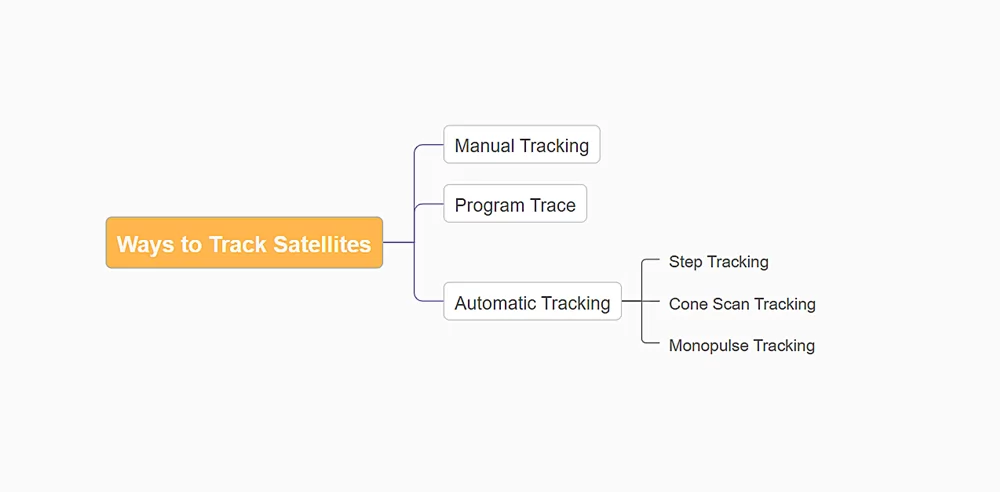For a communications system to function properly, the antenna must be accurately and reliably aimed at the communications satellite. So when you buy an earth satellite antenna, you need to understand how the earth satellite dish tracks satellites.
How Earth Station Antennas Track Satellites
At present, there are generally three methods for the earth station antenna to track satellites, as shown in the following figure:

The various tracking methods are described below:
1. Manual tracking
By manually adjusting the direction of the antenna on time, the received satellite signal is the strongest. Manual tracking is the easiest and is suitable for antennas below 10M (except ship and airborne).
2. Set up program tracking
Input the satellite orbit forecast data and the antenna position angle value from the antenna angle detector together into the computer. The computer processes calculate and compare these data to obtain the angle difference between the satellite orbit and the actual angle of the antenna within the standard time. This value is then fed into the servo circuit to drive the antenna and eliminate the error angle.
3. Automatic tracking
According to the beacon signal sent by the satellite received by the earth station, the error signal is detected, the tracking system is driven, and the antenna is automatically aligned with the satellite. Large and medium-sized earth stations use automatic tracking as the main method, manual tracking, and program tracking as supplementary methods.
Detailed Description of the Automatic Tracking Method
![]()
The principle of automatic tracking is different, and automatic tracking can be divided into three systems:
A: Step-by-step tracking
When the earth station captures the beacon signal transmitted by the satellite, it first moves a certain step angle in a certain direction. At this time, the strength of the beacon signal at the original position is compared. If it is found to be stronger than the original signal, it indicates the direction of movement. Correct, continue to move until the signal is the strongest; if the signal becomes weak, it means that the direction of movement is wrong and should move in the opposite direction until the signal is the strongest.
The above description only analyzes the tracking process from one plane. In fact, the step tracking system performs tracking alternately in the azimuth and pitch planes.
The step-by-step tracking principle and equipment are simple and inexpensive. With the improvement of satellite position accuracy and the rapid development of microcomputer technology, more and more fixed stations tend to use the step-by-step tracking method.
B: Cone scan tracking
Conical scanning tracking is to make a circular motion of the feed horn around the axis of symmetry of the antenna or to tilt and rotate the sub-surface, so that the antenna beam rotates in a conical shape. When the antenna is aligned with the satellite, the level of the beacon received by the earth station is a constant value; when the antenna axis deviates from the satellite, a modulation signal related to the direction of the antenna deviation will be generated, which is judged according to the amplitude and phase of the modulation signal The pointing error of the antenna. The control system will adjust the antenna according to the pointing error value until the antenna is aligned with the satellite.
C: Monopulse Tracking
Monopulse tracking is to determine the direction of the antenna beam deviating from the satellite within a pulse interval and to drive the servo system to quickly align the antenna to the satellite. This antenna has 4 feeds, arranged in 4 quadrants, each feed generates a beam, and the signals of these 4 beams are superimposed; the sum of the upper two beams is subtracted from the sum of the lower two beams, and the result is " Elevation difference" beam; the sum of the two beams on the left and the sum of the two beams on the right are subtracted to obtain the "azimuth difference" beam.
So a monopulse antenna has 1 "sum beam" and 2 "difference beams". When the antenna beam is aimed at the satellite, the antenna can only receive the signal of the "sum beam", and the output of the two "difference beam" signals is zero.
When the "difference beam" is not zero, the control system will adjust the antenna according to the value of the "difference beam" until the antenna is aligned with the satellite.
Conclusion
As a professional manufacturer of earth station antennas, Newstar can provide one-stop satellite antenna solutions for your satellite communication projects. If you have any questions about Earth Antennas we will be happy to answer them. If you are interested in our earth satellite antenna products, then you can contact our experts directly! It will recommend to you our best earth satellite dish.



